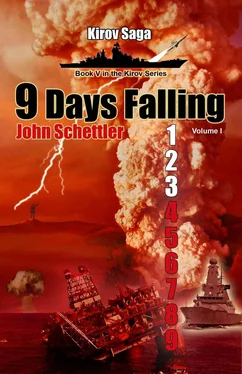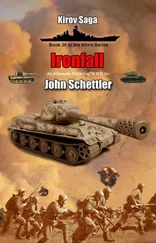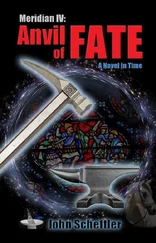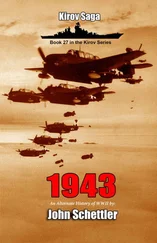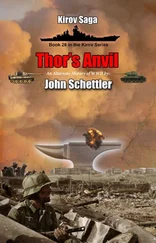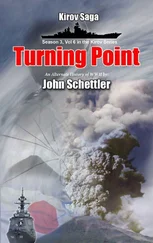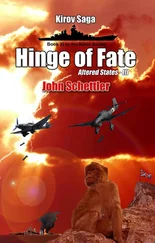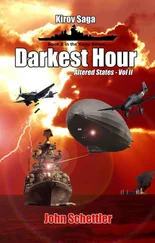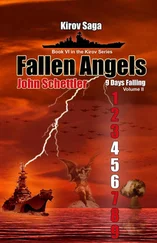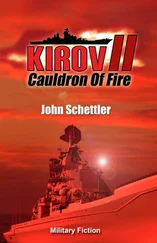The air launched missiles were going to be the real problem, thought Tanner. Anything coming in at that speed reduced the defensive SAMs reaction time to the bare minimum. They had to acquire, track, engage and prosecute that contact, and they may only get a few good shots at a missile that fast, perhaps only one. A few seconds later they got word their AEGIS Cruiser Shiloh was already firing.
“Hell they took a pot shot at those KH-32s with the RIM-161s, sir!” That was the Standard Missile 3, designed for intercepting ballistic missiles. It had the range to even leave the atmosphere and get up after satellites if necessary, and Shiloh was sending a barrage up to see if they could thin the soup on those Backfire launched cruise missiles. To make the shot the AEGIS system was relying on data from the AWACS, as the incoming missiles had not reached the ship’s radar horizon yet. It was a proverbial ‘long shot’ but a good play. Tanner just hoped to God it would help him, but he knew that, with over seventy missiles inbound, something was bound to get through.
His battlegroup was not tightly concentrated. He had destroyers Lassen and McCampbell out on ASW Screen, Wilbur , McCain and Fitzgerald in the inner screen, and CGN Shiloh was in tight.
I should have waited for Nimitz , he thought. That damn Flash-Z traffic forced me to take immediate action against my better judgment, but no one will know or care much about that when this is over and done. If this old girl gets hit, the only thing that will make the news cycle is the smoke and fire. I’ve got 80% of my aircraft aloft, with most of those heading north to send our Harpoons Karpov’s way within the hour. Let’s hope we’ve got a deck here for them to come home. Otherwise they’ll have to land in Japan.
The “war” as it would now be called in all seriousness, was only a matter of minutes away, coming at him in seventy-four screaming anti-ship missiles.
Andit was coming fast.
The KH-32s were going to be a little ahead of the game. Climbing to the dizzying height of 44 kilometers, they quickly acquired the American carrier battlegroup and began their descent. The attack profile was one a ballistic missile might take, though it was deemed ‘semi-ballistic’ in naval circles. It still spelled deadly any way you worded it, and the thirty missiles were diving at Mach-5. Rising to the challenge, CG Shiloh was sending one SM-3 after another up for the chase.
The radar picked up the incoming missiles easily enough, and the enhanced infrared seeker was quick to refine the target data. Even if the missile did boast of a stealthy approach there was no way to hide the heat generated by the incredible speed of the KH-32s. The SM-3 attack was like trying to hit a bullet with a bullet, as it relied on a strike to kill by kinetic impact. When it did hit, however, it did so with the force of a ten ton Mack truck moving at 600 miles per hour. As the missiles climbed, their attitude and course were corrected by precise, short propulsion bursts, an improvement in the latest block of the Raytheon designed missile.
All the corporate sales talk about ‘a more flexible, capable, and cost-effective architecture, improved sensor technologies, and a variety of options to detect and track enemy missiles was now about to be put to the test. It would be a test unlike any other ever run for the missile, which had a good track record in one-on-one engagements under well controlled conditions, but this was the real thing. It wasn’t a test with a missile platform quietly waiting for a target, knowing its timing and approach vector from the start. This time it was thirty missiles all at once, and there was only one catch— Shiloh had only 24 of the SM-3s in inventory, and three of the destroyers had only 12 each. Normal protocol was to fire two missiles at each incoming target. They would barely have enough.
The KH-32s were also getting an assist from another Russian AWACS plane. The A-50s on the AEW line were presumed to be expendable assets if war actually broke out. When Black Bear went down in flames, the Russians were quick to activate their newest addition of the airborne surveillance fleet, the A-100. The plane was built on the capable workhorse of the IL-476 airframe, and upgraded with new advanced AESA radars. It had better loiter time, extended detection range, and resistance to jamming. Positioned behind Kuznetsov’s fighter screen, its life span was more secure, and it was now giving an able assist to the missiles in order to vector them in on their targets. Ignoring the outer destroyer screens, they were after the heart of the American task force, AEGIS Cruiser Shiloh and CVN Washington .
Eighteen SM-3s were in the air already, and Shiloh was pouring it on, her deck and superstructure awash with white and amber smoke as the angry fire of the missiles’ exhaust rocketed them skyward. Anxious crews aboard the ship were watching the radar screens and tracking the engagement. The SM-3s were performing as advertised. They got one, then three of the incoming KH-32s, and the hot race to get the others was intense. After seven kills operators on Shiloh were encouraged until they saw that three missiles were now well below the expected kill altitude from this initial barrage. Three, then five, then seven were through the SM-3 salvo, their incredible speed making a direct hit a very tough prospect. Nine of their brothers had died to penetrate this outer envelope, and a second wave of SM-3s were still engaging the remaining fourteen missiles there, but these lucky seven were now on their way in to the target. Shiloh would have but one last slim chance to get them.
The RIM-162 ESSM (Evolved Sea Sparrow Missile) was that last chance. It had improved range and agility and came four missiles to a cell in a VLS ‘Quad Pack’ on the forward deck. The missiles had seen numerous test firings over the years, swiping target drones from the sky, and defeating slower subsonic anti-ship missiles like the Beech AS-34 Kormoran. The ESSM was designed specifically to deal with supersonic missiles with evasive maneuver capability. Yet design is one thing, testing another and the heat and intensity of real warfare quite another indeed. These were not Kormorans or target drones, nor were they supersonic—they were true hypersonic missiles coming in at nearly 4000 miles or 6500 kilometers per hour. They could cover their entire active range of 1000 kilometers in about ten to twelve minutes accounting for extra time needed in the initial boost phase. Now they were deadly meteors, five times faster than anything the Sparrows had been sent to track and kill before. Twelve missiles were fired from Shiloh’s broiling foredeck, but only three found targets in the precious few seconds before the incoming missiles got into the hot zone. Four KH-32s were going to get through. One would miss, spoofed by countermeasures, three would hit and the battle would shift dramatically on that score alone.
Shiloh took one missile amidships, between the two prominent box-like superstructures that house the valuable radars. The warhead packed a considerable wallop on its own, but the additional kinetic impact imparted by speed was tremendous. It sheared through the mast there destroying the ship’s electro-optical sighting system, the AN/SPS 49 system, and then penetrated the superstructure until it had nearly blown completely through the bottom hull. Black hell was at the center of the ship, which shuddered under the impact, the central mast toppling over the side and into the sea. It was a bulls eye hit, near fatal, and it was going to quickly take Shiloh out of the game for the next crucial minutes when the ship lost power while emergency crews and engineers were scrambling from undamaged sections to fight the intense fire.
Читать дальше
